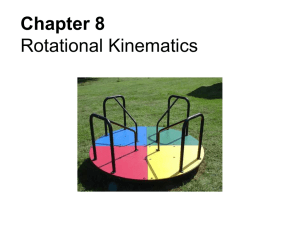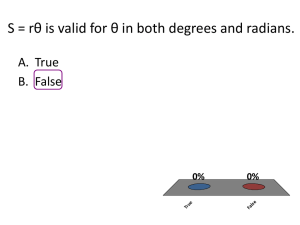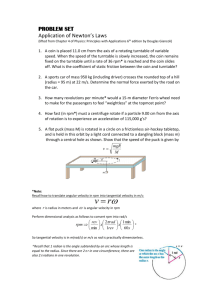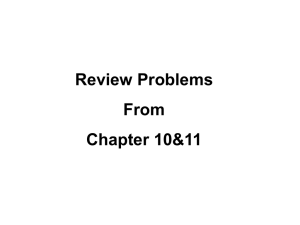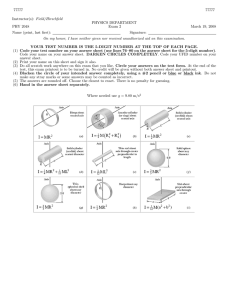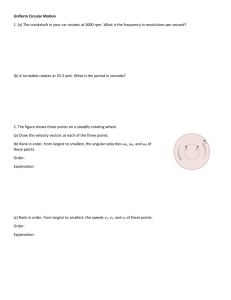77777 Biswas/Ihas/Whiting PHYSICS DEPARTMENT PHY 2053
advertisement
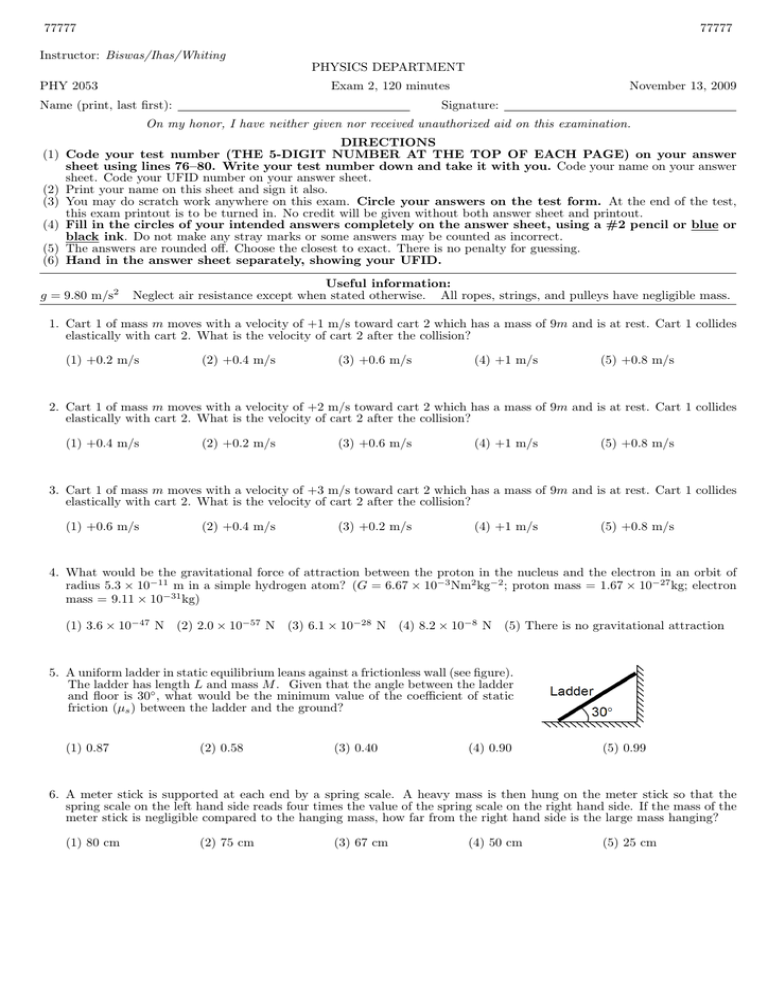
77777 77777 Instructor: Biswas/Ihas/Whiting PHY 2053 PHYSICS DEPARTMENT Exam 2, 120 minutes Name (print, last first): November 13, 2009 Signature: On my honor, I have neither given nor received unauthorized aid on this examination. DIRECTIONS (1) Code your test number (THE 5-DIGIT NUMBER AT THE TOP OF EACH PAGE) on your answer sheet using lines 76–80. Write your test number down and take it with you. Code your name on your answer sheet. Code your UFID number on your answer sheet. (2) Print your name on this sheet and sign it also. (3) You may do scratch work anywhere on this exam. Circle your answers on the test form. At the end of the test, this exam printout is to be turned in. No credit will be given without both answer sheet and printout. (4) Fill in the circles of your intended answers completely on the answer sheet, using a #2 pencil or blue or black ink. Do not make any stray marks or some answers may be counted as incorrect. (5) The answers are rounded off. Choose the closest to exact. There is no penalty for guessing. (6) Hand in the answer sheet separately, showing your UFID. g = 9.80 m/s2 Useful information: Neglect air resistance except when stated otherwise. All ropes, strings, and pulleys have negligible mass. 1. Cart 1 of mass m moves with a velocity of +1 m/s toward cart 2 which has a mass of 9m and is at rest. Cart 1 collides elastically with cart 2. What is the velocity of cart 2 after the collision? (1) +0.2 m/s (2) +0.4 m/s (3) +0.6 m/s (4) +1 m/s (5) +0.8 m/s 2. Cart 1 of mass m moves with a velocity of +2 m/s toward cart 2 which has a mass of 9m and is at rest. Cart 1 collides elastically with cart 2. What is the velocity of cart 2 after the collision? (1) +0.4 m/s (2) +0.2 m/s (3) +0.6 m/s (4) +1 m/s (5) +0.8 m/s 3. Cart 1 of mass m moves with a velocity of +3 m/s toward cart 2 which has a mass of 9m and is at rest. Cart 1 collides elastically with cart 2. What is the velocity of cart 2 after the collision? (1) +0.6 m/s (2) +0.4 m/s (3) +0.2 m/s (4) +1 m/s (5) +0.8 m/s 4. What would be the gravitational force of attraction between the proton in the nucleus and the electron in an orbit of radius 5.3 × 10−11 m in a simple hydrogen atom? (G = 6.67 × 10−3 Nm2 kg−2 ; proton mass = 1.67 × 10−27 kg; electron mass = 9.11 × 10−31 kg) (1) 3.6 × 10−47 N (2) 2.0 × 10−57 N (3) 6.1 × 10−28 N (4) 8.2 × 10−8 N (5) There is no gravitational attraction 5. A uniform ladder in static equilibrium leans against a frictionless wall (see figure). The ladder has length L and mass M . Given that the angle between the ladder and floor is 30◦ , what would be the minimum value of the coefficient of static friction (µs ) between the ladder and the ground? (1) 0.87 (2) 0.58 (3) 0.40 (4) 0.90 (5) 0.99 6. A meter stick is supported at each end by a spring scale. A heavy mass is then hung on the meter stick so that the spring scale on the left hand side reads four times the value of the spring scale on the right hand side. If the mass of the meter stick is negligible compared to the hanging mass, how far from the right hand side is the large mass hanging? (1) 80 cm (2) 75 cm (3) 67 cm (4) 50 cm (5) 25 cm 77777 77777 7. A ball of mass m = 1.0 kg is attached to a light string of length l. The ball is held with the string horizontal as shown in the diagram. Then, the ball is released. What is the tension in the string when the ball is at its lowest point of the circular path? (1) 29 N (2) 59 N (3) 88 N (4) 75 N (5) 45 N 8. A ball of mass m = 2.0 kg is attached to a light string of length l. The ball is held with the string horizontal as shown in the diagram. Then, the ball is released. What is the tension in the string when the ball is at its lowest point of the circular path? (1) 59 N (2) 29 N (3) 88 N (4) 75 N (5) 45 N 9. A ball of mass m = 3.0 kg is attached to a light string of length l. The ball is held with the string horizontal as shown in the diagram. Then, the ball is released. What is the tension in the string when the ball is at its lowest point of the circular path? (1) 88 N (2) 59 N (3) 29 N (4) 75 N (5) 45 N 10. A small bird with a mass of 0.50 kg takes off from the ground and flies with a vertical upward velocity of 3.0 m/s for 10 seconds. Which of the following is closest to the power that must be developed by the bird? Neglect air resistance. (1) 15 watts (2) 60 watts (3) 9.0 watts (4) 6.0 watts (5) 1.5 watts 11. A driver in a 1500 kg sports car wishes to pass a slow moving truck on a two-lane road. What is the average power in watts required to accelerate the sports car from 20 m/s to 40 m/s in 3.0 seconds? (1) 300,000 W (2) 10,000 W (3) 20,000 W (4) 100,000 W (5) 400,000 W 12. Two skaters on a frictionless pond push apart from one another. One skater has a mass of 80 kg and the other a mass of 60 kg. After some time the two skaters are a distance 10 m apart. How far has the lighter skater moved from her original position? (1) 5.7 m (2) 11 m (3) 17 m (4) 2.0 m (5) 25 m 13. Two skaters on a frictionless pond push apart from one another. One skater has a mass of 80 kg and the other a mass of 60 kg. After some time the two skaters are a distance 20 m apart. How far has the lighter skater moved from her original position? (1) 11 m (2) 5.7 m (3) 17 m (4) 2.0 m (5) 25 m 14. Two skaters on a frictionless pond push apart from one another. One skater has a mass of 80 kg and the other a mass of 60 kg. After some time the two skaters are a distance 30 m apart. How far has the lighter skater moved from her original position? (1) 17 m (2) 11 m (3) 5.7 m (4) 2.0 m (5) 25 m 77777 77777 15. Consider the motion of two blocks along a frictionless level track. Block 1 (mass m1 ) is initially moving with speed 10 m/s. It collides with and sticks to an initially stationary block 2 of mass m2 = 9m1 . What is the speed of the two blocks after the collision? (1) 1.0 m/s (2) 2.0 m/s (3) 3.0 m/s (4) 4.0 m/s (5) 5.0 m/s 16. Consider the motion of two blocks along a frictionless level track. Block 1 (mass m1 ) is initially moving with speed 20 m/s. It collides with and sticks to an initially stationary block 2 of mass m2 = 9m1 . What is the speed of the two blocks after the collision? (1) 2.0 m/s (2) 1.0 m/s (3) 3.0 m/s (4) 4.0 m/s (5) 5.0 m/s 17. Consider the motion of two blocks along a frictionless level track. Block 1 (mass m1 ) is initially moving with speed 30 m/s. It collides with and sticks to an initially stationary block 2 of mass m2 = 9m1 . What is the speed of the two blocks after the collision? (1) 3.0 m/s (2) 2.0 m/s (3) 1.0 m/s (4) 4.0 m/s (5) 5.0 m/s 18. If a planet of radius 6000 km spins with an angular velocity ω = 10 × 10−5 rad/s about an axis through the North Pole, what is the ratio of the normal force experienced by a person at the equator to that experienced by the same person at the North Pole? Assume a constant acceleration due to gravity of 10 m/s2 and that at both places the person is stationary relative to the planet and is at sea level. (1) 0.99 (2) 0.60 (3) 0.85 (4) 0.45 (5) 0.25 19. If a planet of radius 10000 km spins with an angular velocity ω = 20 × 10−5 rad/s about an axis through the North Pole, what is the ratio of the normal force experienced by a person at the equator to that experienced by the same person at the North Pole? Assume a constant acceleration due to gravity of 1.0 m/s2 and that at both places the person is stationary relative to the planet and is at sea level. (1) 0.60 (2) 0.99 (3) 0.85 (4) 0.45 (5) 0.25 20. If a planet of radius 2000 km spins with an angular velocity ω = 30 × 10−5 rad/s about an axis through the North Pole, what is the ratio of the normal force experienced by a person at the equator to that experienced by the same person at the North Pole? Assume a constant acceleration due to gravity of 1.2 m/s2 and that at both places the person is stationary relative to the planet and is at sea level. (1) 0.85 (2) 0.60 (3) 0.99 (4) 0.45 (5) 0.25 21. Riders in a carnival ride stand with their backs against the wall of a circular room of diameter 8.0 m. The room is spinning horizontally about an axis through its center at a rate of 45 rev/min when the floor drops so that it no longer provides any support for the riders. What is the minimum coefficient of static friction between the wall and the rider required so that the rider does not slide down the wall? (1) 0.11 (2) 0.0012 (3) 0.056 (4) 0.53 (5) 8.9 22. A roller-coaster vehicle has a mass m of 504 kg when fully loaded with passengers (see figure). If the vehicle has a speed of 21.0 m/s at point A (bottom of the dotted circle), what is the force of the track on the vehicle at this point? (1) 27200 N (2) 19300 N (3) 23400 N (4) 12100 N (5) 10100 N 77777 77777 23. A roller-coaster vehicle has a mass m of 498 kg when fully loaded with passengers (see figure). If the vehicle has a speed of 17.0 m/s at point A (bottom of the dotted circle), what is the force of the track on the vehicle at this point? (1) 19300 N (2) 27200 N (3) 23400 N (4) 12100 N (5) 10100 N 24. A roller-coaster vehicle has a mass m of 509 kg when fully loaded with passengers (see figure). If the vehicle has a speed of 19.0 m/s at point A (bottom of the dotted circle), what is the force of the track on the vehicle at this point? (1) 23400 N (2) 19300 N (3) 27200 N (4) 12100 N (5) 10100 N 25. A car rounds a banked curve where the radius of curvature of the road is R, the banking angle is θ, and the coefficient of static friction is µ. What is the maximum speed with which the car can round the curve if R = 110 m, θ = 10◦ , and µ = 0.130? (1) 18.4 m/s (2) 20.4 m/s (3) 21.1 m/s (4) 23.2 m/s (5) 24.8 m/s 26. A car rounds a banked curve where the radius of curvature of the road is R, the banking angle is θ, and the coefficient of static friction is µ. What is the maximum speed with which the car can round the curve if R = 145 m, θ = 10◦ , and µ = 0.110? (1) 20.4 m/s (2) 18.4 m/s (3) 21.1 m/s (4) 23.2 m/s (5) 24.8 m/s 27. A car rounds a banked curve where the radius of curvature of the road is R, the banking angle is θ, and the coefficient of static friction is µ. What is the maximum speed with which the car can round the curve if R = 140 m, θ = 10◦ , and µ = 0.140? (1) 21.1 m/s (2) 20.4 m/s (3) 18.4 m/s (4) 23.2 m/s (5) 24.8 m/s 28. A coin rests 15.1 cm from the center of a turntable. The coefficient of static friction between the coin and turntable surface is 0.350. The turntable starts from rest at t = 0 and rotates with a constant angular acceleration of 0.646 rad/s2 . After what period of time will the coin start to slip on the turntable? (1) 7.38 s (2) 5.42 s (3) 6.65 s (4) 1.47 s (5) 1.51 s 29. A coin rests 16.8 cm from the center of a turntable. The coefficient of static friction between the coin and turntable surface is 0.350. The turntable starts from rest at t = 0 and rotates with a constant angular acceleration of 0.833 rad/s2 . After what period of time will the coin start to slip on the turntable? (1) 5.42 s (2) 7.38 s (3) 6.65 s (4) 1.47 s (5) 1.51 s 30. A coin rests 14.7 cm from the center of a turntable. The coefficient of static friction between the coin and turntable surface is 0.350. The turntable starts from rest at t = 0 and rotates with a constant angular acceleration of 0.726 rad/s2 . After what period of time will the coin start to slip on the turntable? (1) 6.65 s (2) 5.42 s (3) 7.48 s (4) 1.47 s (5) 1.51 s 77777 77777 31. A rotating wheel requires 8.00 s to rotate 28.0 revolutions. Its angular velocity at the end of the 8.00 s interval is 95.0 rad/s. What is the constant angular acceleration of the wheel? (1) 18.3 rad/s2 (2) 27.4 rad/s2 (3) 24.3 rad/s2 (4) 12.6 rad/s2 (5) 10.2 rad/s2 32. A rotating wheel requires 5.00 s to rotate 25.0 revolutions. Its angular velocity at the end of the 5.00 s interval is 100.0 rad/s. What is the constant angular acceleration of the wheel? (1) 27.4 rad/s2 (2) 18.3 rad/s2 (3) 24.3 rad/s2 (4) 12.6 rad/s2 (5) 10.2 rad/s2 33. A rotating wheel requires 6.00 s to rotate 26.0 revolutions. Its angular velocity at the end of the 6.00 s interval is 100.0 rad/s. What is the constant angular acceleration of the wheel? (1) 24.3 rad/s2 (2) 27.4 rad/s2 (3) 18.3 rad/s2 (4) 12.6 rad/s2 (5) 10.2 rad/s2 34. A 11.0 g bullet is fired horizontally into a 103 g wooden block that is initially at rest on a frictionless horizontal surface and connected to a spring having spring constant 145 N/m. The other end of the horizontal spring is attached to an immovable wall. The bullet becomes embedded in the block. If the bullet-block system compresses the spring by a maximum of 72.0 cm, what was the speed of the bullet at impact with the block? (1) 266 m/s (2) 303 m/s (3) 364 m/s (4) 404 m/s (5) 808 m/s 35. A 12.0 g bullet is fired horizontally into a 101 g wooden block that is initially at rest on a frictionless horizontal surface and connected to a spring having spring constant 144 N/m. The other end of the horizontal spring is attached to an immovable wall. The bullet becomes embedded in the block. If the bullet-block system compresses the spring by a maximum of 90.0 cm, what was the speed of the bullet at impact with the block? (1) 303 m/s (2) 266 m/s (3) 364 m/s (4) 404 m/s (5) 808 m/s 36. A 10.0 g bullet is fired horizontally into a 108 g wooden block that is initially at rest on a frictionless horizontal surface and connected to a spring having spring constant 152 N/m. The other end of the horizontal spring is attached to an immovable wall. The bullet becomes embedded in the block. If the bullet-block system compresses the spring by a maximum of 86.0 cm, what was the speed of the bullet at impact with the block? (1) 364 m/s (2) 303 m/s (3) 266 m/s (4) 404 m/s (5) 808 m/s 37. A 2500 kg car moving east at 10.0 m/s collides with a 3000 kg car moving north. The cars stick together and move as a unit after the collision, at an angle of 34.0◦ north of east and at a speed of 5.48 m/s. Find the speed of the 3000 kg car before the collision. (1) 5.62 m/s (2) 7.67 m/s (3) 9.20 m/s (4) 11.5 m/s (5) 14.7 m/s 38. A 2300 kg car moving east at 10.0 m/s collides with a 3000 kg car moving north. The cars stick together and move as a unit after the collision, at an angle of 45.0◦ north of east and at a speed of 6.14 m/s. Find the speed of the 3000 kg car before the collision. (1) 7.67 m/s (2) 5.62 m/s (3) 9.20 m/s (4) 11.5 m/s (5) 14.7 m/s 39. A 2400 kg car moving east at 10.0 m/s collides with a 3000 kg car moving north. The cars stick together and move as a unit after the collision, at an angle of 49.0◦ north of east and at a speed of 6.77 m/s. Find the speed of the 3000 kg car before the collision. (1) 9.20 m/s (2) 7.67 m/s (3) 5.62 m/s (4) 11.5 m/s (5) 14.7 m/s 77777 77777 40. One end of a uniform 8.0 m long rod of weight w is supported by a cable. The other end rests against the wall at point A, where it is held by friction (see figure). The coefficient of static friction between the wall and the rod is µs = 0.50. Determine the minimum distance, x, from point A at which an additional weight w (the same as the weight of the rod) can be hung without causing the rod to slip at point A. (1) 5.6 m (2) 7.8 m (3) 3.9 m (4) 0.50 m (5) 2.1 m 41. Air track car Z of mass 1.5 kg approaches and collides with air track car R of mass 2.0 kg. Car R has a spring attached to it and is initially at rest. When the separation between the cars has reached a minimum, which of the following is correct? Neglect friction on the air track. (1) (2) (3) (4) (5) The kinetic energy of the system has reached a minimum. Car R is still at rest. Car Z has come to rest. Both cars have the same kinetic energy. Both cars have the same momentum. 42. A Hooke’s law spring is compressed a distance d and is used to launch a particle of mass m vertically to a height h above its starting position. Under double the compression, the spring is now used to launch a particle of mass 2m. How high does the second mass rise above its starting position? (1) 2h (2) h (3) 3h (4) 4h (5) h/2 77777 FOLLOWING GROUPS OF QUESTIONS WILL BE SELECTED AS ONE GROUP FROM EACH TYPE TYPE 1 Q# S 1 Q# S 2 Q# S 3 TYPE 2 Q# S 7 Q# S 8 Q# S 9 TYPE 3 Q# S 12 Q# S 13 Q# S 14 TYPE 4 Q# S 15 Q# S 16 Q# S 17 TYPE 5 Q# S 18 Q# S 19 Q# S 20 TYPE 6 Q# S 22 Q# S 23 Q# S 24 TYPE 7 Q# S 25 Q# S 26 Q# S 27 TYPE 8 Q# S 28 Q# S 29 Q# S 30 TYPE 9 Q# S 31 Q# S 32 Q# S 33 TYPE 10 Q# S 34 Q# S 35 Q# S 36 TYPE 11 Q# S 37 Q# S 38 Q# S 39 77777
